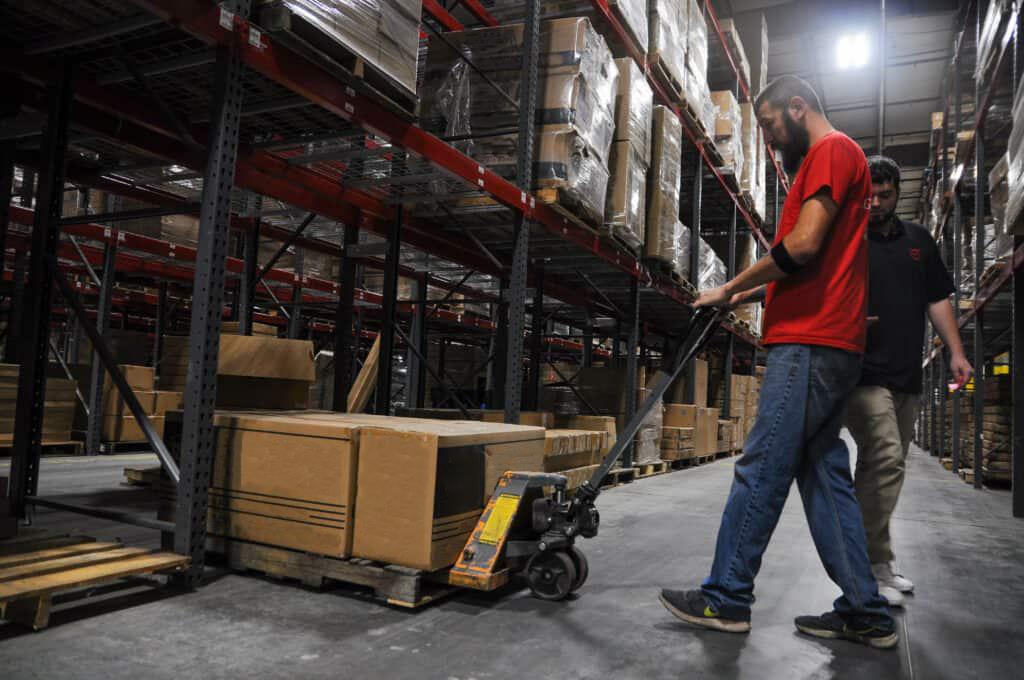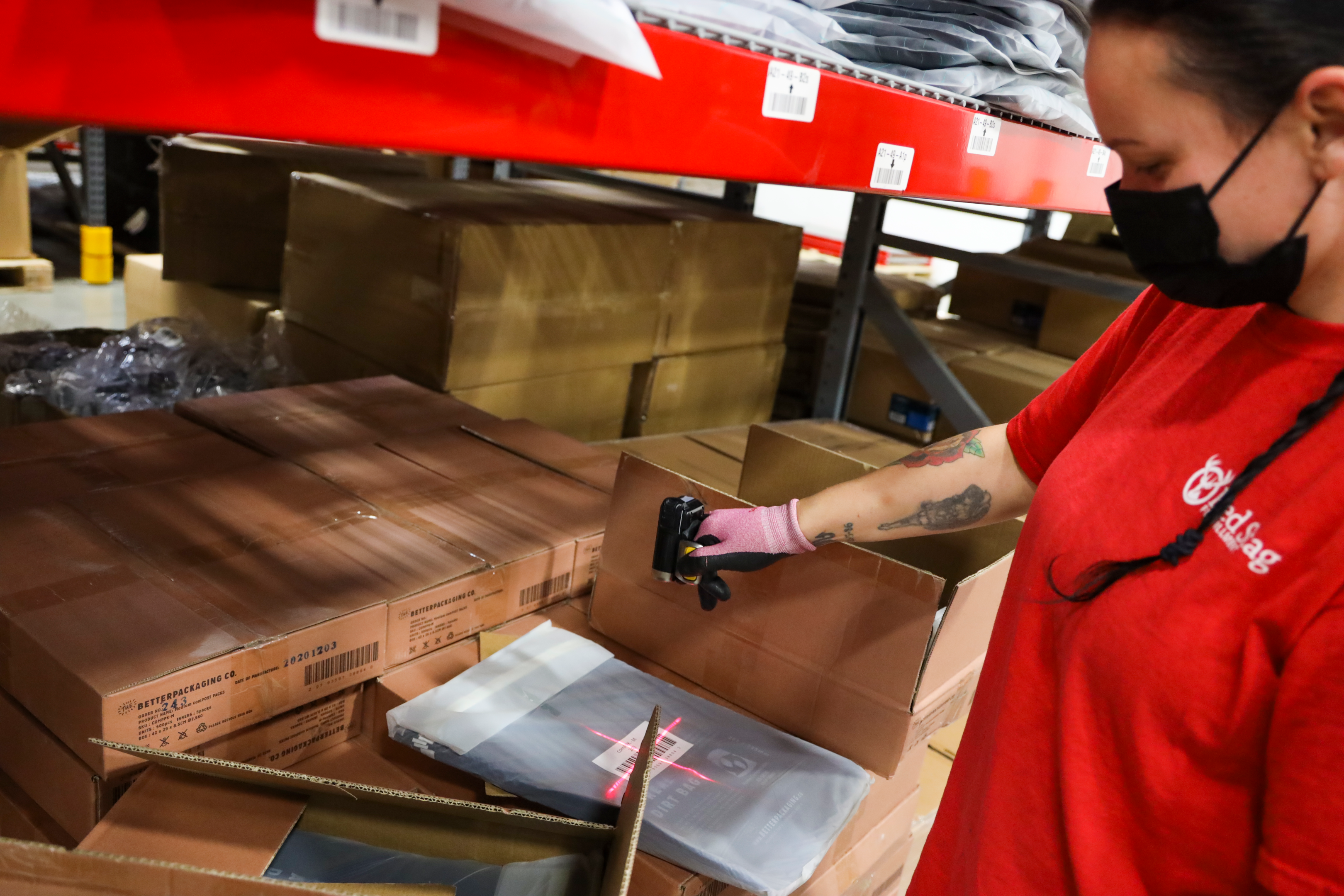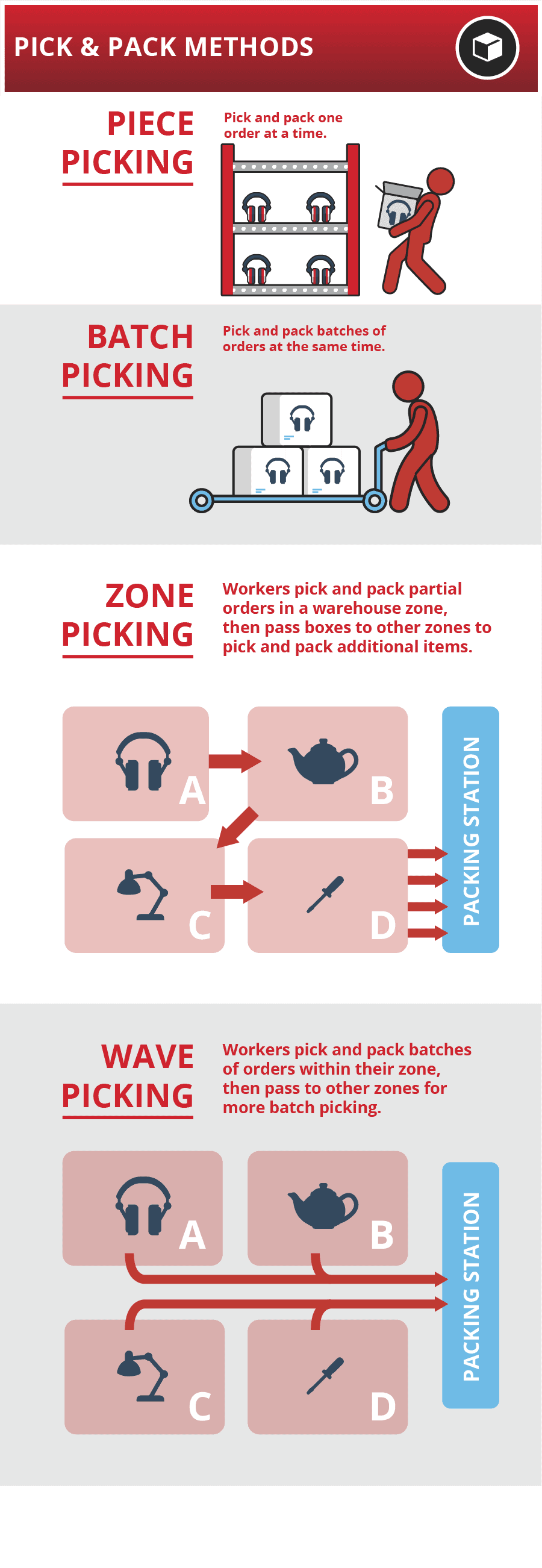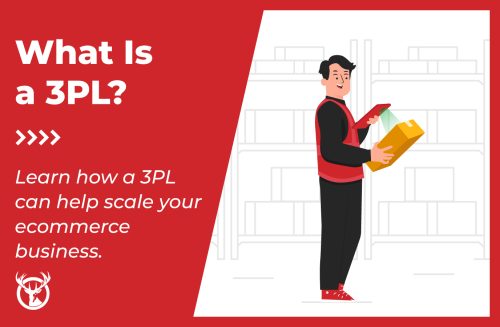Order picking is a key step in your fulfillment, bringing items from where they’re stored to where they can be packed for delivery. Getting it right supports customer satisfaction and helps keep fulfillment costs under control.
Read on to learn about picking strategies and tactics to optimize your business.
What is order picking?

Order picking is the selection and retrieval of items from a warehouse. It’s a core activity in warehouses and kicks off the order fulfillment process.
You can also define order picking as part of a larger process known as pick and pack, which includes packaging the items into boxes for handoff to last-mile delivery carriers. Picking and packing are both essential for getting items to customers.

How does order picking work?
Here’s how the order picking process works:
01
When a customer places an order, your online store shares the information with your warehouse.
02
A warehouse management system (WMS) produces a packing slip and assigns picking to one or more warehouse staff. This part of the process should happen almost immediately after the order is placed, especially if you promise to fulfill orders in two days or less. Real-time order information is vital to efficient fulfillment and helps support customer satisfaction.
03
Once warehouse staff receive the packing slip, they walk or drive machinery to the area in the warehouse where items are stored.
04
They select the ordered quantity of each item and verify order accuracy manually or with a barcode or radio frequency identification (RFID) scanners.
04
After items are picked, staff bring them to packing stations, where other staff package the items for shipping.
If you manage a large warehouse or work with a third-party logistics (3PL) provider, your picking process may involve different inventory management strategies and picking tactics. That’s because quickly picking high volumes of SKUs can be challenging. Warehouse managers and other fulfillment experts focus on the details to help you maintain efficiency and optimize costs. picking strategies in warehouse locations.

Why does order picking matter?
An accurate warehouse order picking process is key to maintaining high levels of customer satisfaction and keeping fulfillment costs predictable.
Picking errors can result in shipping customers the wrong items or quantities of items. Even if errors are caught before packages ship, they can cause delays that disappoint customers.
When these things happen, you may have to deal with returns, replacements, and customer attrition. At scale, returns can crush profit margins because you lose the profit on the original sale and the costs of order fulfillment and reverse logistics. You may not always be able to resell items at full price, either.
You might even lose customers over these mistakes. That hurts your overall brand loyalty and can lead to higher customer acquisition costs. For every customer you lose, you have to pay to find new ones or watch your revenue dip.
Order picking is also important because it’s closely linked to effective inventory management. The process provides valuable data that can show you which products sell well, which need pricing adjustments or promotions, and which should be discontinued. This can further help you maintain optimal stock levels to meet customer demand.
If you work with a 3PL, they can use this data to help you increase turnover, reduce carrying costs, and maximize customer pricing.

Warehouse picking strategies
There are several warehouse picking methods that can optimize efficiency and accuracy based on your business and its orders. The following are some common tactics.
Discrete picking

With discrete picking, also referred to as piece picking, warehouse staff are assigned to pick individual items one order at a time.
This method works mostly for businesses with limited warehouse order picking needs and only a few SKUs per order. It can also offer flexibility, since staff can adjust picking routes quickly in smaller warehouses.
As your business grows, you’ll likely need to graduate to a different picking system. Higher order volumes may require staff pick multiple orders at once or split orders based on item quantities and locations.
Batch picking

Batch picking assigns warehouse staff to pick orders based on where items are stored in the warehouse. Each staff member collects the items assigned to them and places them in a bin to be sorted downstream in the picking process.
This method lets staff pick several orders at once to increase efficiency, even with a separate step for sorting.
Batch picking usually requires a WMS to guide picking assignments and pick paths within the warehouse. That makes the method a better fit for mid-sized or large companies.
Cluster picking

Cluster picking is similar to batch picking because warehouse staff pick multiple order items all at once. The difference is that cluster picking groups orders by order size or shipping method.
Warehouses typically need a WMS to guide picking assignments and pick paths for this method, too.
Zone picking

Zone picking adds complexity to picking, but boosts efficiency. Pickers work in specific warehouse zones, collecting items from their zone and moving them across the warehouse for sorting before reaching the packing station.
WMS picking tools guide this method, which is ideal for businesses with a high number of customer orders and several SKUs per order.
Wave picking

Wave picking is a method where warehouses mix batch picking and zone picking by moving batches across zones.
This is can be pretty complex, but having pickers handle higher volumes of orders simultaneously can translate to increased productivity and efficiency. Wave picking also enables warehouses to optimize the use of equipment like forklifts or picking carts.
Wave picking works best for top-performing businesses with thousands of monthly orders and many different products.
Zone-batch picking

A zone-batch picking method combines the zone and batch picking strategies. Pickers are assigned to specific zones within the warehouse to pick all the items needed for a batch of orders within their assigned zone.
This allows pickers to consolidate picks for multiple orders in a single trip.
Zone-wave picking

In this hybrid method, pickers are assigned to specific zones, similar to zone picking. But unlike batching, they pick all the items for orders within their zone during planned waves.
This helps synchronize and optimize the overall order fulfillment process by coordinating picking activities at a high level.
Zone-batch-wave picking

This is the most complex hybrid picking method, combining zone, batch, and wave order picking strategies. Pickers are assigned to specific zones and pick multiple SKUs for a batch of orders within their zone. Additionally, warehouse managers schedule multiple waves or time slots per shift for these batch picks to occur.

How to select a picking system
Your business needs determine which warehouse picking process is right for you. It’s also common for warehouses to blend tactics based on order volume, SKUs per order, available equipment, and the warehouse size and layout.
By order volume
For warehouses with low order volume, a discrete or single-order picking strategy is often the best approach. It’s a straightforward method and simple to implement.
As order volume increases, more advanced strategies like batch or zone picking and hybrid methods become more beneficial. For example, batch picking allows pickers to consolidate items for multiple orders, while zone picking optimizes travel time in larger warehouses.
For very high-volume operations, a combination of these methods, such as zone-batch or zone-batch-wave picking, can provide the greatest gains in productivity.
By SKU volume
The number of unique SKUs in a warehouse can impact the complexity of your picking process.

Discrete picking is suitable for low SKU counts when pickers can easily navigate the inventory.

Zoning makes more sense for larger warehouses, reducing the time spent searching for items.

Wave methods can help you meet fulfillment expectations by assuring time to pick high numbers of items.
Warehouse layout
The physical layout of the warehouse can also play a significant role in determining the most effective picking method.

Smaller warehouses can usually fulfill orders on time with discrete picking.

In bigger warehouses, zone picking minimizes travel time and increases productivity.

Batch and wave picking can work in these scenarios, too, because they reduce the number of trips pickers need to make, but may not be as efficient as zone picking.
Integrations and technology
Integrations serve to streamline order picking, notifying warehouses when orders come in and maintaining order status information across systems. It’s important that your integrations send notifications in real time, so that picking starts shortly after customers place orders. Process visibility can also help you resolve errors and exceptions and identify opportunities for improvement.
Your process may also benefit from semi-automated systems like pick-to-light, voice picking, and robotic picking, which can increase efficiency and accuracy. These tactics may be best for businesses with several thousands of orders each month. Some small and mid-sized businesses may not be able to justify the costs of advanced WMS integrations and automated picking tools.
Keeping up with competitors
As online shopping evolves, large retailers and marketplaces like Amazon shape what customers expect. These brands can offer same-day and next-day delivery on millions of products.
If you want to keep up, you need to optimize each stage of your fulfillment process to deliver orders as quickly as possible. This means selecting the picking method that works best for your business. Using a 3PL may also provide access to resources that keep you competitive.

Key performance indicators for order picking
Optimizing fulfillment requires tracking and measuring key performance indicators (KPI) for your order picking process. The following common KPIs can provide valuable insights into your accuracy, efficiency, and costs.
Accuracy
An accuracy KPI tracks the percentage of orders picked correctly on the first attempt. This is a North Star metric for many fulfillment centers.
You can also look at other accuracy metrics across your warehouse to see how they may impact picking accuracy. For example, if there are receiving errors, you may not be able to pick every order accurately due to an inventory management gap.
Efficiency
- Picking productivity
Also referred to as units picked per hour, this KPI measures the number of orders or items picked per hour at a team or individual level - Picking cycle time
This KPI measures the time to complete the entire picking process for an order, including picker assignments, travel time through warehouses, item selection and delivery to packing stations, and system updates - Average distance traveled
This KPI measures how much distance pickers cover while picking and indicates opportunities to reorganize warehouses or switch to zone picking.
Cost
- Picking cost
This measures labor and material costs by orders and SKUs and can be adjusted to measure how productivity impacts cost. - Labor utilization
In contrast to productivity measurement, this gauges how labor is allocated across efforts and typically refers to teams. - Equipment utilization
This KPI includes how equipment is being used, including idle time, storage or moving capacity, and assignment to certain areas of the warehouse.
Common challenges to consider
Meeting KPIs, keeping costs in check, and satisfying customers requires overcoming obstacles in the order picking process. Here are some common challenges and solutions to consider.
Errors and exceptions
Picking errors and exceptions derail accuracy and can lead to costly returns or shipping delays. You can work to avoid these missteps or try to prevent them before they happen.

Implement verification systems, like barcode scanning or RFID technology, to make sure pickers select the right items.

Optimize warehouse layout and storage locations for different items to reduce errors.

Provide thorough training for pickers to instill the importance of accuracy.
Order prioritization
Another key challenge in order picking is balancing the need to fulfill orders quickly while still maintaining efficiency and accuracy. You can offset challenges with different picking solutions and tactics.

Picking strategies, like zone, batch, and wave picking, can help streamline processes.

Warehouse order picking tools can help guide prioritization based on order volumes, SKU volumes per order, and delivery promises to customers.

Orders that require special attention, like large or heavy items, may be picked first to allow ample lead time for optimized packaging.
Scalability
Maintaining adequate labor and equipment availability to meet changing demand is a common challenge for warehouses. During peak seasons or growth periods, you may need additional resources to fulfill orders on time.

Working with 3PLs provides access to broader resources related to labor allocation and specialized equipment.

If your volume justifies the cost, you can look into automated or semi-automated systems that help scale order picking.

Use your fulfillment data to plan ahead, identifying when demand may increase, so you can hire temporary help or let partners know what to expect.

Outsourcing order picking
For many businesses, outsourcing order picking to a 3PL can offer significant advantages. By leveraging the expertise and resources of a specialized fulfillment partner, companies can streamline their operations, reduce costs, and improve overall performance.
Consider these benefits to determine if outsourcing could be right for your company.
Improved accuracy and efficiency
3PLs have established processes in place for a high degree of picking accuracy. They also offer access to advanced WMS features and integrations, specialized equipment, and highly trained teams that include warehouse staff and supply chain experts.
Fulfillment partners may also have value-add services like kitting and assembly, reverse logistics, and demand planning to help you create even more efficiency across your supply chain.
Fulfillment cost optimization
Discover opportunities for cost optimization in order picking and other steps in the fulfillment process.
3PLs benefit from economies of scale, allowing them to negotiate better rates with carriers, packaging material suppliers, and other service providers.
They can also leverage their expertise to identify opportunities for cost reduction, such as optimizing inventory levels, reducing labor expenses, and minimizing waste.
Scalability on demand
Scale your order picking capabilities as needed. It’s normal to experience fluctuations in your business. Seasonal trends and shifts in demand patterns can require flexibility. A 3PL may be better equipped to handle variability due to the breadth of its operations.
This lets you respond quickly to market demands without the need to invest in costly infrastructure or maintain excess labor and storage capacity during slower periods.

Work with Red Stag Fulfillment
At Red Stag Fulfillment, we specialize in order picking as part of our end-to-end fulfillment services. Our supply chain experts can help you optimize your processes for cost, speed, and efficiency, so you can focus on running the rest of your business.
Our strategically located warehouses fulfill orders to 96% of U.S. addresses in two days or less, and our performance guarantees protect your business from risk while holding us accountable to our promises. In the rare event of a mistake, we’ll fix it at no cost to you and pay you a fee for the inconvenience.
If we make a mistake that hurts your business, it’s only right that it should hurt ours, too. This level of accountability lets you trust that Red Stag’s motivations are always aligned with yours. No other 3PL has guarantees that come close to this.
Ready to get started? Reach out to start a conversation.










